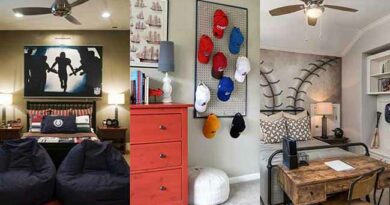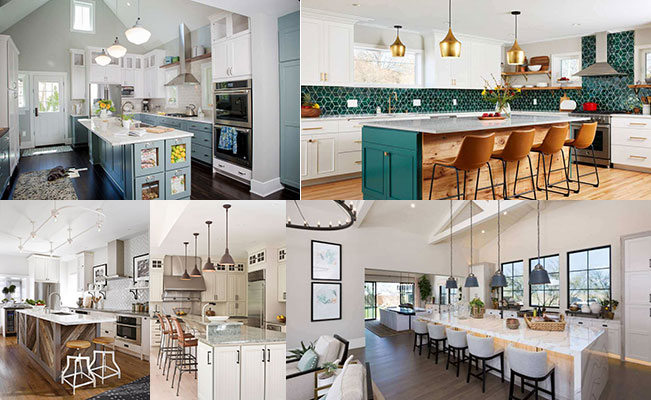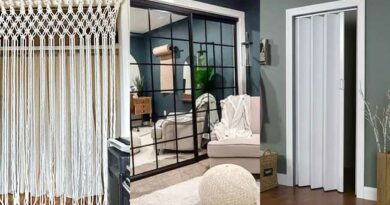30 Best Kitchen Counter Stools for Every Home Style (With Pro Selection Guide)
Whether you’re sipping coffee at your kitchen island or entertaining guests with cocktails, your counter stools are more than just seats—they’re silent design heroes. But how do you pick the perfect one for your space, style, and comfort? Let’s break it down with a designer’s eye—and plenty of stunning examples.
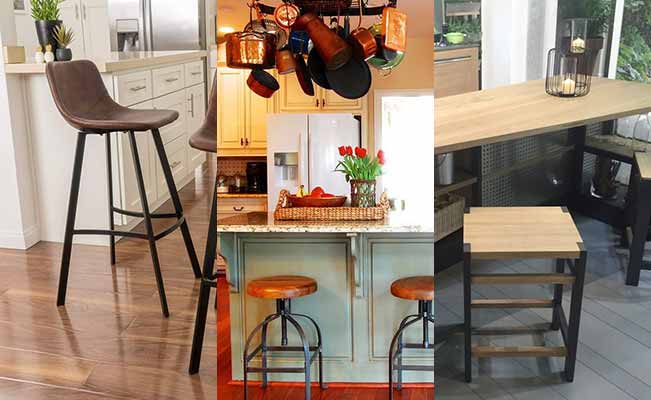
Adding kitchen counter stools to a space can make the kitchen more than just a place to cook. In homes with kitchen islands, stools help turn that area into a spot for eating, chatting, or doing small tasks. Not all kitchens have room for stools, but if there is space, they can improve the look and function of the kitchen.
For those planning to add an island, it’s a smart idea to leave space for some stools. Talk to a designer to figure out which stool style fits best with the kitchen’s theme. It’s important to choose stools that match the kitchen decor while also being useful and comfortable.
There are many kinds of stools to use with a kitchen island. Some have a more traditional feel, made of wood with padded seats, while others look more modern.
Common Mistakes to Avoid When Choosing Counter Stools
Choosing kitchen stools involves more than finding a pretty design. Here are three missteps many homeowners make:
Confusing Counter Stools with Bar Stools: Counter stools typically work with 36″ high surfaces and are 24–27″ tall. Bar stools are taller (28–32″) and fit bar-height surfaces of 40–42″. Always measure your island or counter before shopping.
Overlooking Comfort: Stools without a footrest can be uncomfortable, especially for extended sitting. Likewise, lack of back support or padding may make the seats uninviting.
Ignoring Style Harmony: Clashing colors or materials disrupt kitchen flow. Choose stools that echo your cabinetry, flooring, or hardware for a cohesive look.
Finding the Right Height – Visual Guide
Getting stool height right is critical for comfort and visual balance:
Counter Height (36″) → Use stools that are 24–27″ tall.
Bar Height (40–42″) → Use stools that are 28–32″ tall.
Allow 9–12″ of clearance between seat and countertop underside. For example, a 36″ countertop pairs best with a 24–26″ seat height.
| Table/Counter Height | Recommended Stool Seat Height | Common Usage |
|---|---|---|
| 28″–30″ (71–76 cm) | 16″–18″ (41–46 cm) | Standard dining tables |
| 34″–36″ (86–91 cm) | 24″–26″ (61–66 cm) | Kitchen counters |
| 40″–42″ (102–107 cm) | 28″–30″ (71–76 cm) | Bar counters or pub tables |
| 45″–48″ (114–122 cm) | 32″–34″ (81–86 cm) | Extra-tall commercial bars |
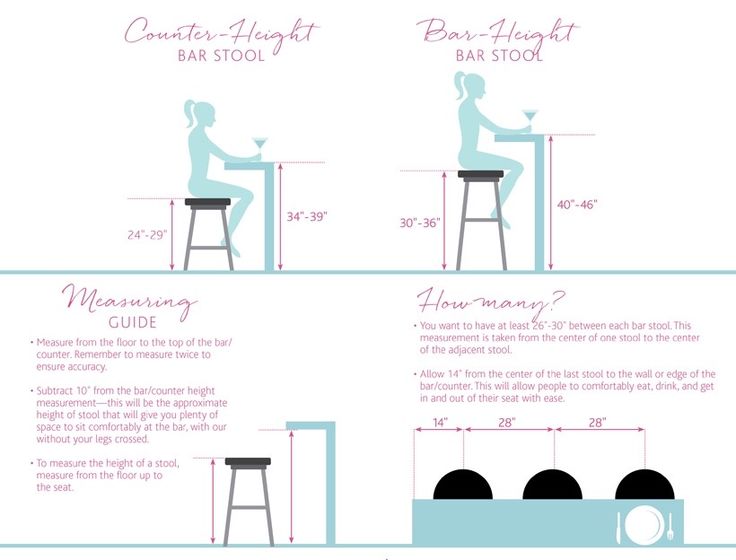
PDF file: Choose the Right Height Stool, Table, and Chair.
Match the Stool to Your Kitchen Style
Your kitchen’s character can help guide the best stool pick:
Farmhouse Style: Look for natural woods, cross-backs, or distressed finishes. Soft curves and muted tones fit perfectly.
Modern Minimalist: Sleek pedestal stools, slim legs, and monochrome colors work beautifully.
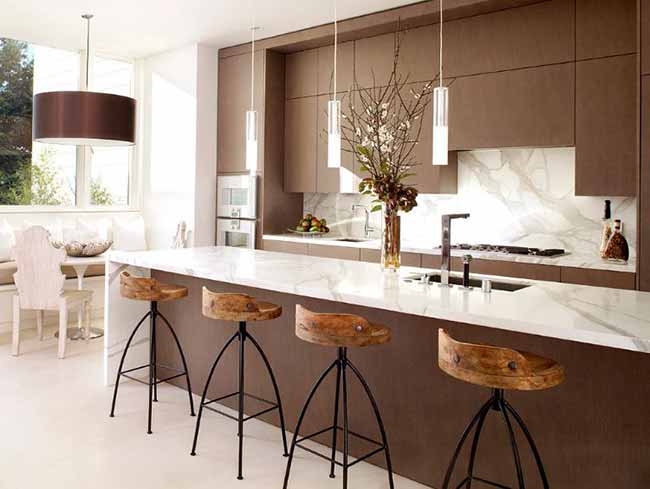
Industrial Look: Metal frames, reclaimed wood, and visible rivets create a rugged vibe.
Coastal Casual: Think rattan, wicker, or bleached finishes for a breezy aesthetic.
Consider the User – Who’s Sitting on These Stools?
Different users need different features:
For Families with Children: Safety is paramount in family households, especially with young children. Tall, unstable stools with narrow bases can be risky. Swivel mechanisms and sharp corners may appeal in sleek showrooms, but they pose challenges when kids are climbing up and down several times a day.
For these reasons, stools with fixed bases, sturdy backrests, and wide leg spacing offer a more stable experience. Upholstered seats covered in wipe-clean materials—such as faux leather or coated fabric—can also make life easier during snack time and spills.
For Seniors: Choose stools with armrests, padded seats, and wide footrests to ease getting up and down.
Look for models with:
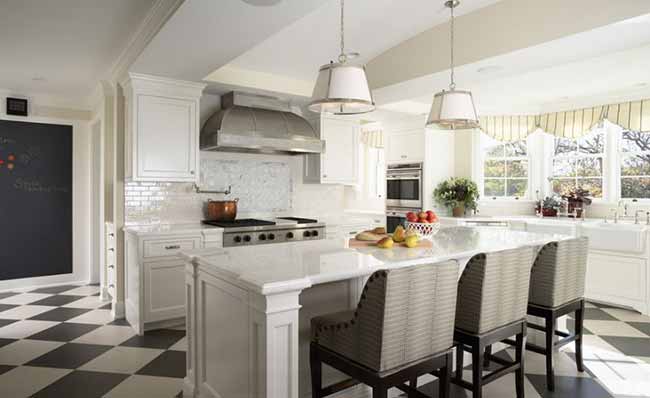
Footrests that support leg alignment
Armrests that assist with getting up
Generous seat depth and back support
Textured or non-slip feet to prevent sliding
In homes where elderly family members use the kitchen frequently, these stools can greatly improve both safety and confidence.
For Social Kitchens: For homeowners who love entertaining, counter stools should be a blend of comfort and flexibility. Seating that supports longer conversations and lingering meals should include soft cushions, supportive backs, and some adjustability in height.
Swivel stools often work well in these settings—they make it easy to turn and talk without constantly repositioning. Bonus points go to stools that can be stacked or tucked under counters when not in use, maximizing space between guests.
Kitchen Counter Stool Styles
There are many stool styles to fit every kitchen. Here are a few common types:
1. Swivel Stools
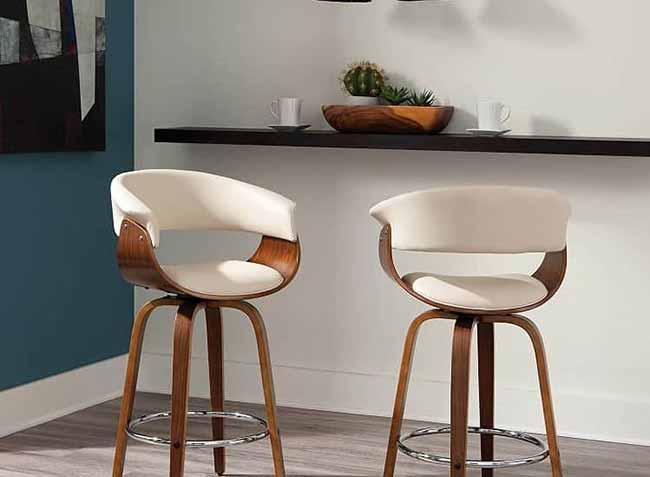
Swivel stools turn 360 degrees, making it easy to talk with others or move around without getting up. This is handy when entertaining guests.
Swivel seats adjust without lifting the whole stool. But these might not be safe for young kids who could fall off.
2. Folding Stools
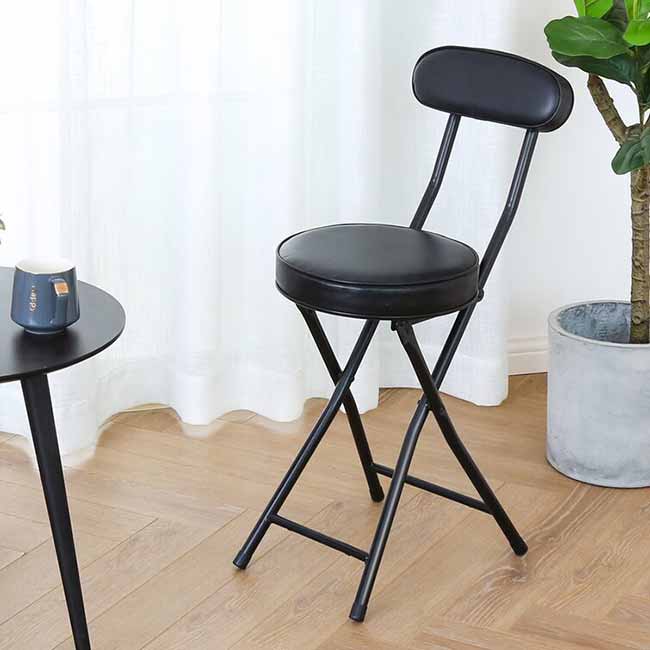
Folding stools are helpful when space is limited. They can be folded and stored away easily when not needed, making them perfect for extra guests.
These stools are usually metal and backless. Be careful while folding them, as the moving parts might pinch fingers. It’s better to keep these away from children.
3. Three-Legged Stools
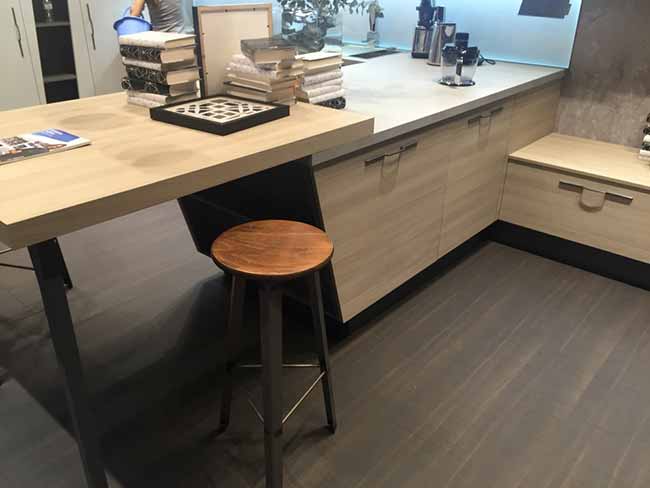
Three-legged stools are often made of wood and are a popular choice for bars. They’re sturdy and simple in design, with a round, flat seat.
These stools are stackable, which makes cleaning and storing them easy. They’re practical and cost-effective.
What Is the Typical Weight Limit for Kitchen Bar Stools?
When it comes to commercial-grade kitchen bar stools, they generally boast a higher weight capacity compared to residential models. Most commercial stools are engineered to support up to 400 pounds, with some high-end variants capable of withstanding even greater loads. If the stool is constructed from sturdy steel, it not only ensures high weight tolerance but also offers durability for long-term, intensive use in busy environments such as bars or restaurants.
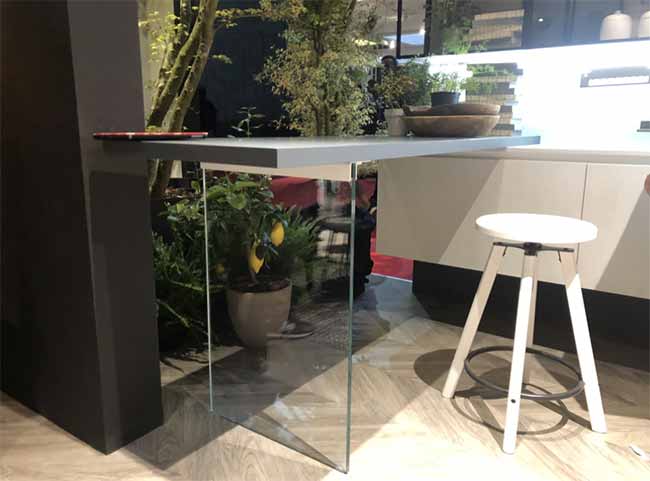
While wooden bar stools may not rival steel versions in terms of raw strength, they still maintain an impressive load-bearing ability. Most can safely hold up to 325 pounds or more, making them suitable for everyday use. Their strength largely depends on the type of wood and craftsmanship involved. On the other hand, plastic bar stools, though seemingly lightweight, are often engineered with structural reinforcements that allow them to bear a surprisingly substantial amount of weight. So, a slimmer appearance doesn’t always mean reduced strength.
4. Four-Legged Stools
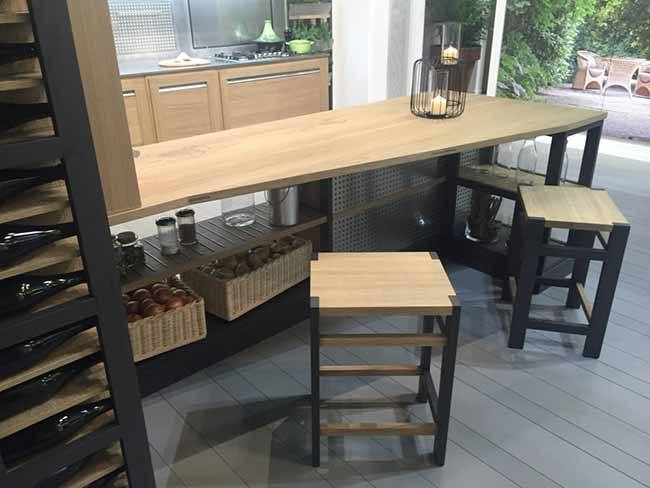
Four-legged stools are designed with legs in a square shape. The seat can be either round or square.
They offer great stability and come in many styles—from thick wooden ones to slim metal options. Most have a horizontal support bar to serve as a footrest.
5. Pedestal Stools
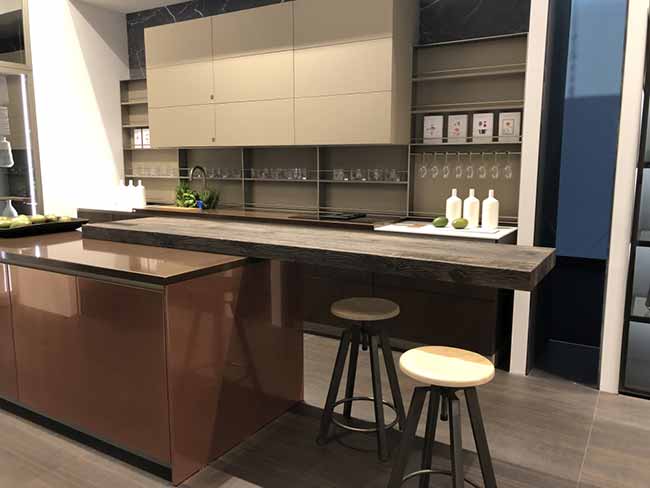
Pedestal stools have just one center support and a wide base under the seat. The base is usually round and about the same size as the seat for better balance.
These stools often include a swivel feature and adjustable height. They don’t tangle under the bar like legged stools, but their base takes up more floor space. They’re also heavier and not stackable.
6. Backless Stools
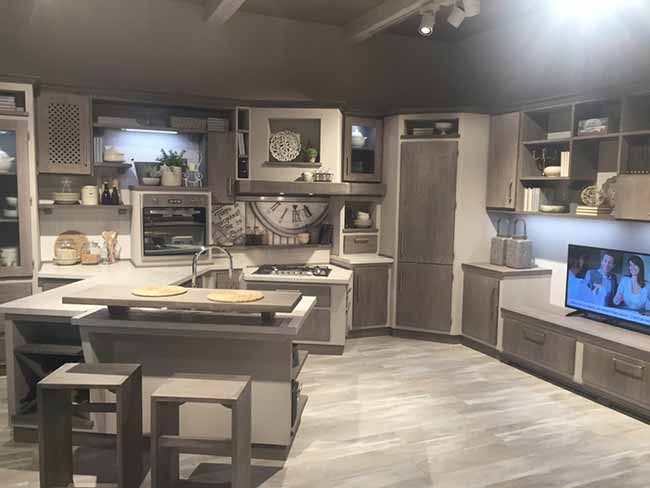
Backless stools don’t have any kind of back support. The seat is flat, so it can be used from any direction.
Even if the stool doesn’t swivel, it’s easy to turn around on a backless stool. These are common in bars, though some may have shaped seats that only work facing one way.
7. Low-Back Stools
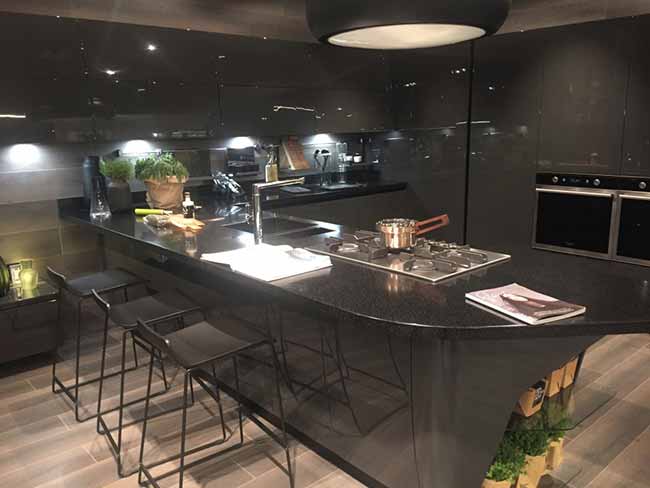
Low-back stools are a mix between full-back and backless stools. They offer some support without being too visible over the counter.
While they don’t allow leaning back much, they provide enough backing to stop someone from sliding off. They also keep the kitchen looking neat from the other side of the counter.
8. Open-Back Stools
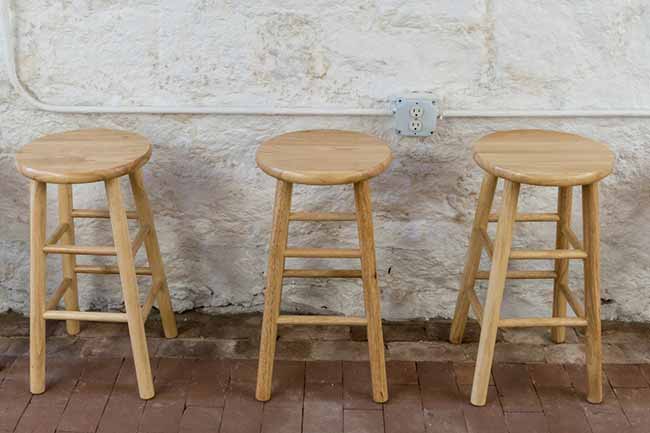
Open-back stools have a partial or framed backrest instead of a solid one. Some have vertical bars, wooden crosses, or even decorative shapes.
These designs are popular in more traditional stool styles. Some metal versions have a ladder-style frame. Others might have a padded backrest held by two side rods, creating an open space at the lower back for comfort and style.
9 Unique Bar Stools with Baseball Bat Legs
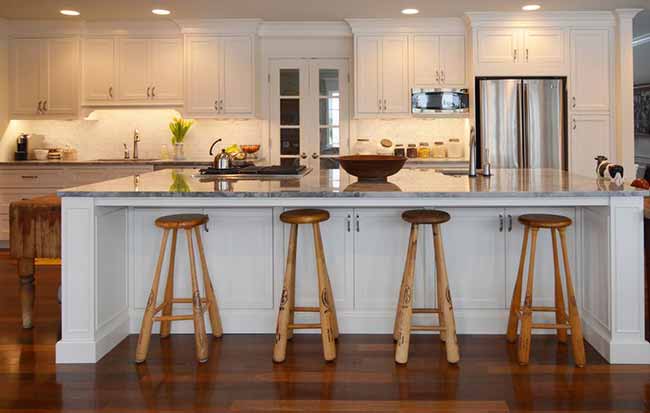
Some kitchen stools are more than just a place to sit—they’re conversation starters. These handcrafted bar stools feature legs made from real baseball bats, giving them a fun, sports-inspired look. Each stool is made to order, so no two are exactly the same. They’re perfect for game rooms, basement bars, or kitchens where you want to show off a bit of personality. Despite the playful design, they’re built to be sturdy and practical.
How Many Bar Stools Can You Fit Around a Kitchen Island?
Once your kitchen island’s dimensions have been accurately measured, the next step is to calculate the optimal number of bar stools it can accommodate. This decision isn’t solely based on length—it’s crucial to maintain adequate spacing to ensure comfort. Each individual should have enough room to eat, drink, or chat without bumping elbows.
A good rule of thumb is to allow 26 to 30 inches of space between the centers of each bar stool. This spacing promotes better posture, movement, and overall convenience. Overcrowding the island with too many stools not only looks cluttered but also restricts usability.
10 Custom Saddle Stools to Match Your Countertop
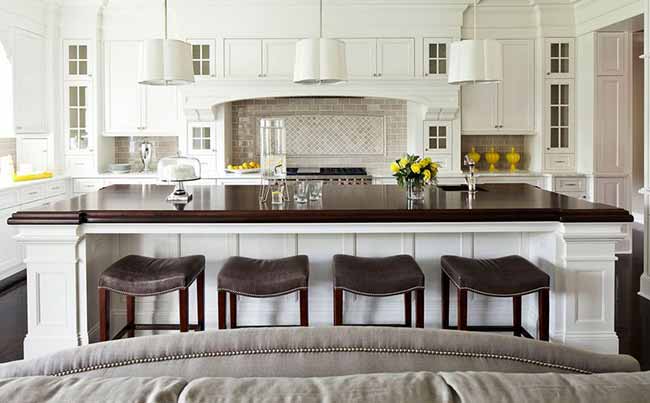
Saddle-style bar stools are a great choice for adding rustic charm or western flair to a kitchen. When custom-made, they can be designed to match the color and texture of your countertop, creating a seamless, coordinated look. This is especially useful in open-plan kitchens where the island and stools are always in view. Be sure to select materials that are both attractive and durable—wood and leather are popular options for this style.
11 Classic Farmhouse Swivel Stools
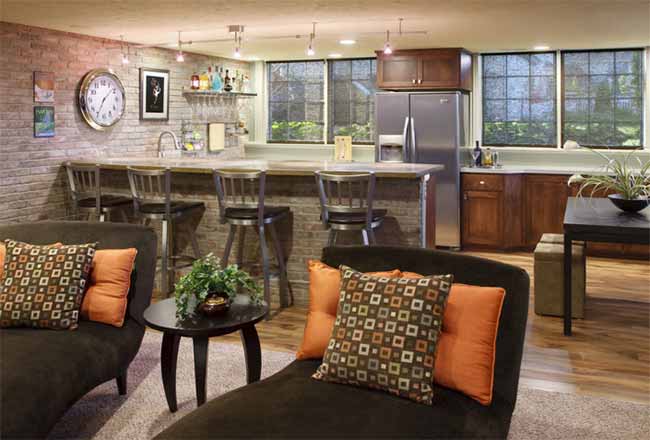
Wooden swivel stools with a spindle-style back are a staple in farmhouse kitchens. The classic design, often called a jailhouse back, pairs well with wood beams, shiplap, and vintage fixtures. A swivel base adds everyday convenience, especially in busy kitchens where people are constantly moving around the island. These stools work best in warm wood finishes like oak, walnut, or distressed white.
12 Height-Adjustable Swivel Stools for Everyday Use

Swivel stools with adjustable height are one of the most practical choices for kitchen islands. They make it easy for both kids and adults to sit comfortably and also allow for smooth movement during meals or conversations. Look for designs with built-in footrests and soft seating if you plan to use them daily. This type of stool is especially popular in contemporary kitchens with open layouts.
13 Seating Solutions for Irregular Kitchen Islands
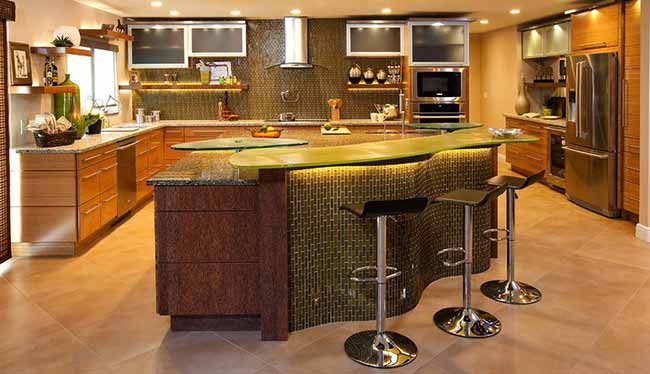
Not all kitchen islands are perfectly square or rectangular. Some have rounded edges or angled corners, which can make stool placement tricky. In these situations, backless stools or models with smaller seat widths can help avoid crowding. It’s important to measure carefully and test for comfort before deciding. A well-chosen stool can adapt to the shape of the island without sacrificing style or usability.
14 Built-In Stools for Small Spaces

In compact kitchens, built-in stools are a clever space-saving solution. These stools are fixed to the island, often with a swivel base or sliding track, so they don’t take up extra room. This design also makes it easier to maintain equal spacing between seats. Built-ins are especially useful in apartments or tiny homes where maximizing floor space is essential.
15 Fold-Away or Floating Bar Stools
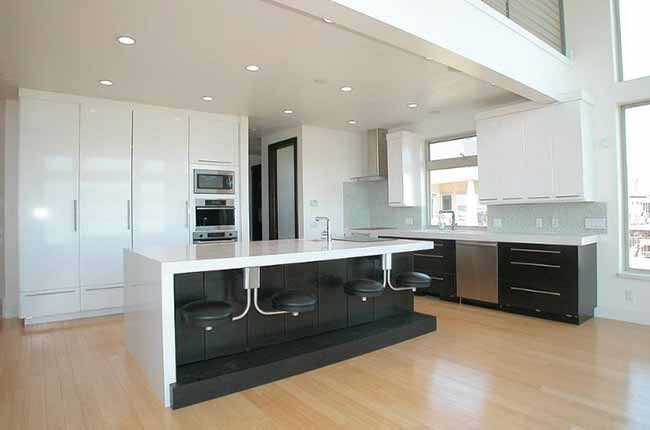
For ultra-modern kitchens, floating stools or fold-away designs offer a sleek, clutter-free look. These stools are mounted directly to the island, allowing them to fold under or to the side when not in use. They’re often seen in minimalist interiors where clean lines and smart storage matter. While they don’t offer the same cushion or back support as traditional stools, their space-saving benefits are hard to beat.
16 Eco-Friendly Cork and Wood Stools
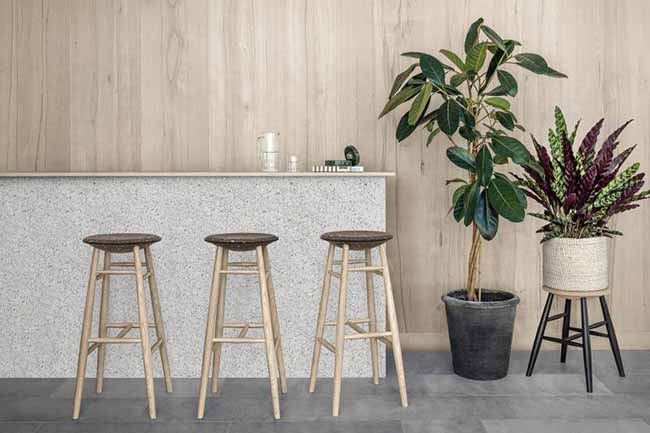
The Drifted stool by designer Lars Beller Fjetland combines natural materials with smart design. It features a solid ash wood frame with a cork seat—both lightweight and sustainable. The seat comes in light or dark cork to match the wood’s natural or black finish. Cork is surprisingly comfortable, and its soft texture adds warmth to any kitchen. These stools are perfect for Scandinavian-style spaces or anyone looking for eco-conscious furniture options.
17. Slim Modern Bar Stools with Wood and Metal Details
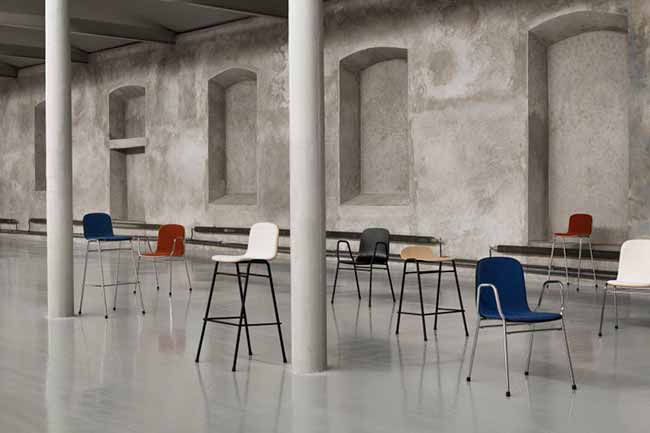
Designed by Lars Beller Fjetland, the Touchwood bar stool brings together Scandinavian simplicity and industrial strength. Its sleek, powder-coated steel legs form a slim silhouette, making it ideal for kitchens with limited space or a modern minimalist design. The molded wooden seat is gently contoured with a low-profile backrest, offering surprising comfort despite its streamlined form. Available in twelve different color and finish combinations, this stool can blend in with neutral-toned kitchens or serve as a bold accent in colorful interiors. Whether paired with a marble island or a concrete countertop, this modern bar stool delivers both function and visual lightness.
18. Wool Upholstered Stools with Classic Round Seats
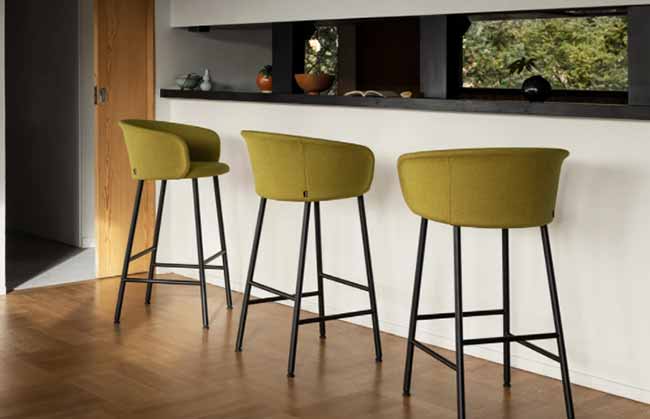
The Kendo bar stool by LucidiPevere proves that even the simplest shapes can carry style. With a perfectly round, generously cushioned seat wrapped in wool fabric, it introduces softness and texture into any kitchen setting. The minimal metal frame keeps the look clean and allows the stool to tuck easily under a counter. It’s offered in four rich colors, letting homeowners add subtle vibrancy without overpowering the space. This is a perfect fit for kitchens that favor clean lines and muted palettes but still want a hint of comfort and color contrast.
19. Swivel Bar Stools with Rustic Industrial Charm
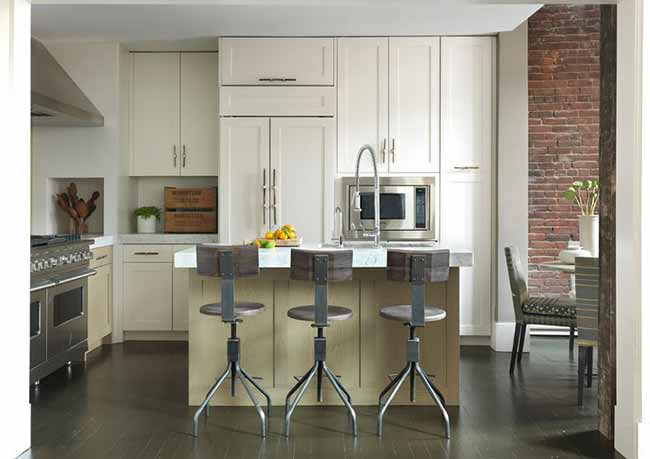
Blending raw materials with a practical swivel function, these rustic-industrial bar stools are built for kitchens with character. Featuring exposed metal bases and wooden seats, they create a balanced mix of warmth and toughness. The stools include a supportive backrest but forgo armrests to keep the design open and versatile. They work particularly well against exposed brick or concrete backdrops, complementing industrial lofts or farmhouse kitchens with weathered textures. These stools aren’t just a style statement—they’re built to handle daily use in busy, lived-in kitchens.
20. Oversized Traditional Bar Stools with Leather Seats
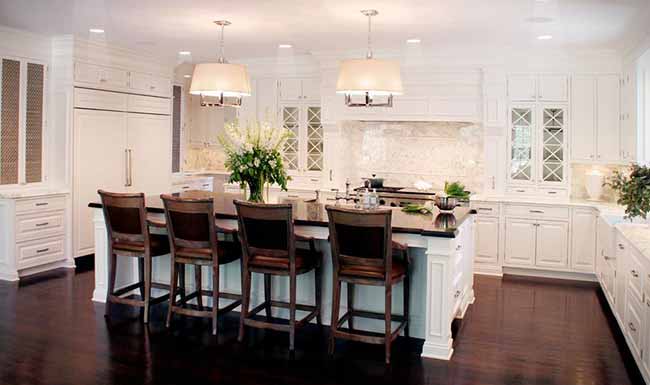
For a kitchen that leans toward traditional elegance, oversized leather bar stools offer both luxury and comfort. These stools typically feature deep, padded seats upholstered in smooth or tufted leather, creating a refined and formal appearance. The wide seat and tall back provide excellent support, making them ideal for long dinners or entertaining guests around the kitchen island. A sturdy wood frame, often in rich walnut or espresso finishes, adds to the overall grandeur. These are perfect for larger kitchen layouts where space allows for substantial seating.
21. Upholstered Bar Stools with Built-In Back Support

The Marcello stool is a modern option for those who want upholstered comfort without the bulk of armrests. Its clean-lined form includes a cushioned backrest that adds ergonomic support, while the armrest-like shapes are purely decorative, keeping the stool visually light. Though it lacks adjustable height, the fixed seat level suits most standard counters and islands. These stools are ideal for transitional kitchens where comfort is key, but the overall aesthetic stays sleek and uncluttered. Upholstery options in neutral tones make coordination with kitchen décor easy and elegant.
22. Chrome and Wood Stools for Contemporary Kitchens
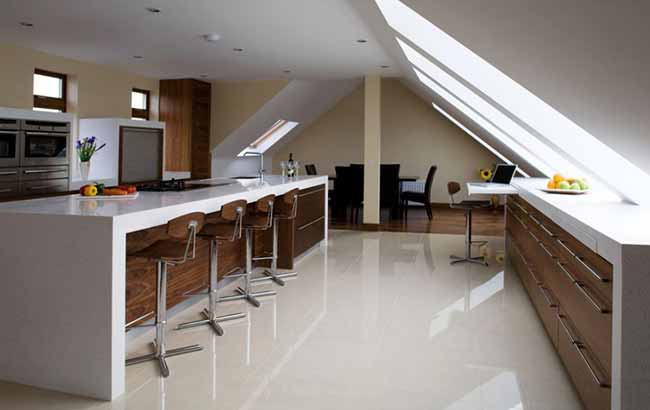
The Enzo stool blends warm wooden details with cool chrome finishes, offering a contemporary look that feels both polished and approachable. The wooden seat and backrest bring in a touch of organic texture, while the chrome frame reflects light and matches well with stainless steel appliances. A built-in footrest adds practical comfort, making these stools suitable for both everyday dining and hosting guests. Their balanced design makes them versatile enough for modern, mid-century, or even transitional kitchens.
23. Minimalist Metal and Wood Stools for Versatile Use
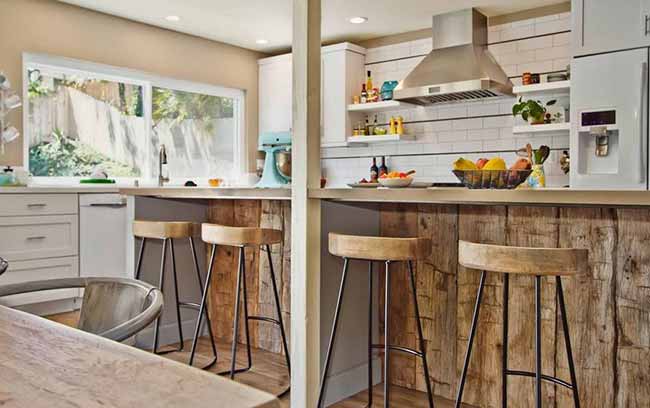
With their no-frills silhouette, these metal-and-wood bar stools are a staple in kitchens where function meets style. A simple wood seat sits atop a sturdy metal base, creating a look that feels natural yet industrial. Without a back or arms, these stools are easy to slide under the island, saving space while maintaining a clean visual line. They work beautifully in open-plan layouts, blending into rustic, urban, or Scandinavian kitchen designs. Their lightweight form also makes them easy to move, reposition, or use in multi-purpose spaces like breakfast nooks or home bars.
24. Handcrafted Bar Stools with Cast Iron Legs

The Arteriors bar stool is a striking blend of raw industrial strength and artisanal detail. It features slim yet sturdy cast iron legs, giving the stool a strong architectural presence while maintaining a minimal footprint. The wooden seat is hand-carved, with subtle textures and patterns that make each piece slightly different. Most notably, the seat swivels and adjusts in height, making it a flexible option for counters and islands of varying dimensions. The combination of iron and wood fits beautifully in loft-style kitchens or rustic-industrial interiors, offering both durability and visual appeal.
25. Modern Leather Bar Stools with Slim Frame
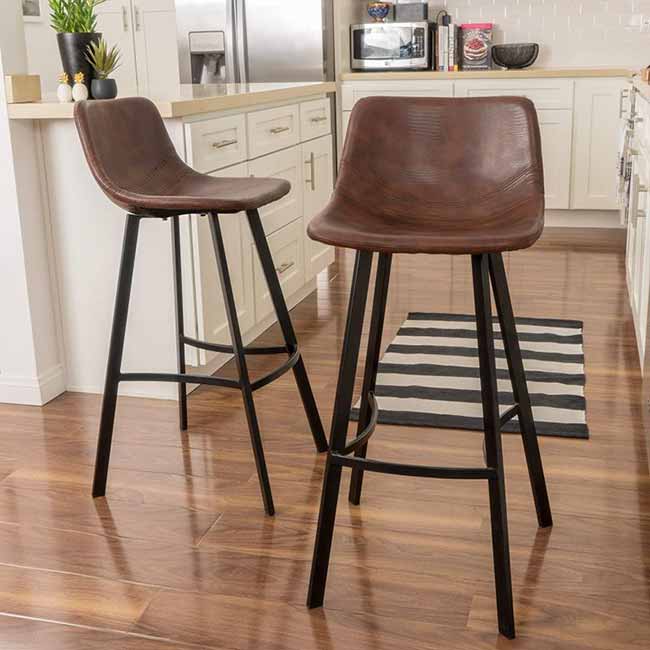
These kitchen stools offer a sleek, no-fuss aesthetic ideal for contemporary spaces. The frame is made from slim metal tubing, giving the stool a clean, open look while remaining stable and supportive. The seat features a gentle curve with a low backrest, upholstered in smooth faux leather that adds sophistication without bulk. The design strikes a balance between comfort and minimalism, making these stools a smart choice for modern apartments or kitchens with a streamlined, urban feel. They’re especially useful when you want something understated that still offers proper support.
26. Solid Wood Bar Stools with Clean Lines

Sometimes the best choice is the simplest one. These round-top bar stools are made entirely of solid wood and come in finishes like natural, black, or walnut, allowing them to blend effortlessly into a range of kitchen styles. With no upholstery or extra ornamentation, they’re durable, easy to clean, and great for high-traffic areas like breakfast bars or kitchen islands. The sturdy legs and circular seat keep the design grounded and functional, while the minimalist shape makes them easy to tuck under counters when not in use.
27. Farmhouse-Inspired Wooden Bar Stools
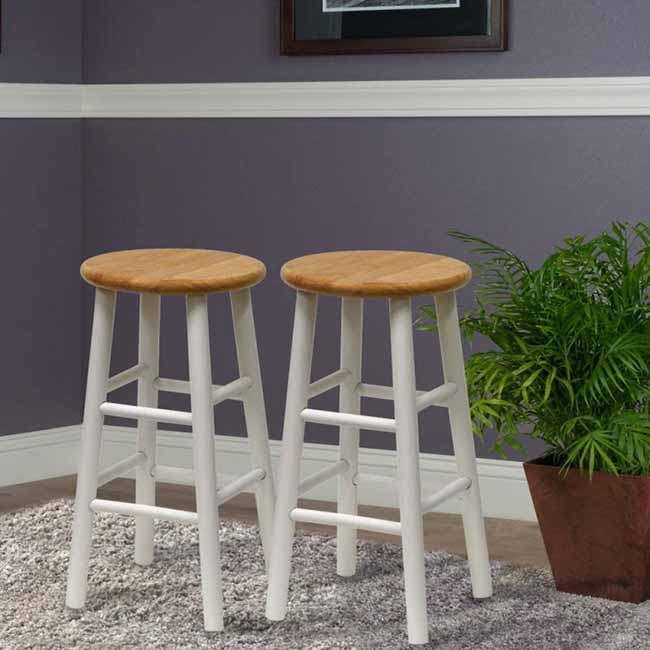
Rustic charm meets everyday functionality in these country-style bar stools. Made from solid wood, they feature a straightforward design that allows them to pair effortlessly with farmhouse, cottage, or even transitional kitchens. Available in several finish options—from crisp white to rich espresso—the stools bring warmth and approachability to the kitchen space. Their backless form and compact footprint make them an excellent choice for cozy layouts or informal dining nooks. They prove that simplicity can still be stylish.
28. Elegant Swivel Bar Stools with Classic Details
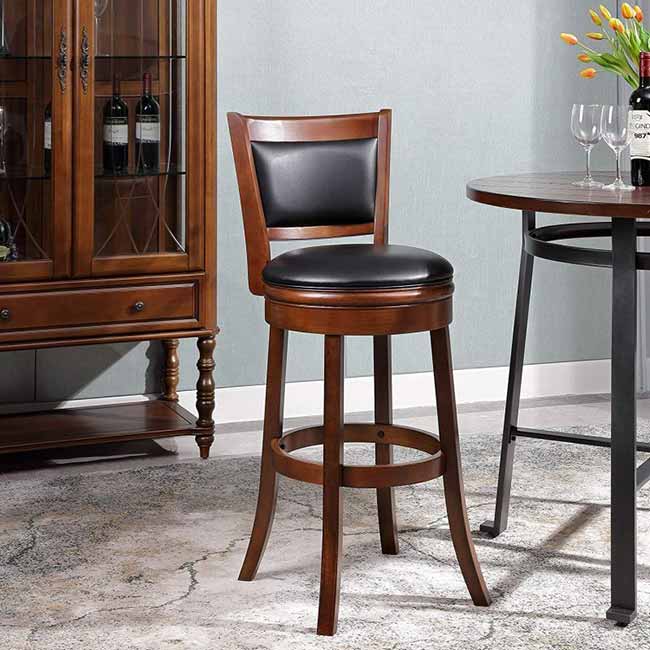
With their curved legs, padded faux leather seat, and gently arched backrest, these stools bring a touch of traditional elegance to any kitchen. The solid wood frame offers long-lasting support, while the seat’s 360-degree swivel function makes them ideal for conversational seating. A hidden swivel mechanism and curved footrest enhance the design’s sophistication. Perfect for upscale kitchen islands or bar counters, these stools are both stylish and comfortable—especially if you prefer a more polished, formal aesthetic without sacrificing functionality.
29. Cushioned Bar Stools with Armchair Comfort
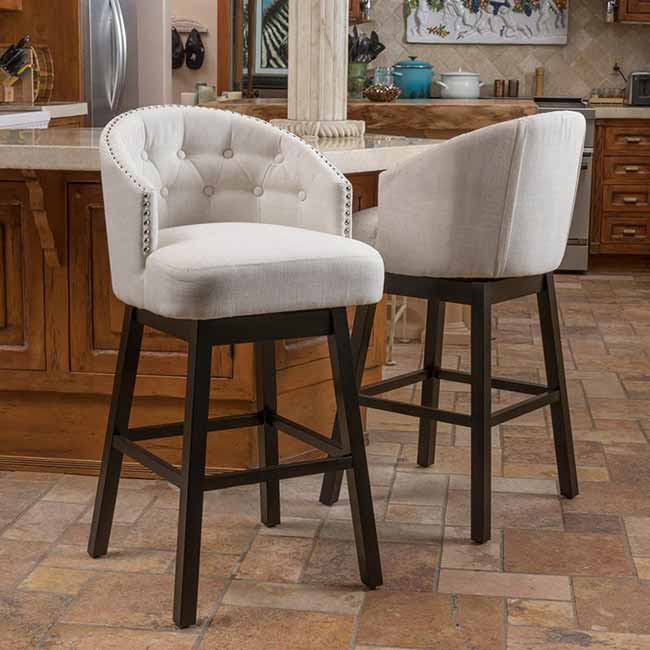
Inspired by the shape and comfort of a classic armchair, the Ogden bar stool blends casual luxury with functional design. Its sturdy wood frame is enhanced by a fully upholstered seat and backrest in a soft beige fabric, accented with button tufting and nailhead trim for added texture and refinement. The wide seat and curved back provide real support, while the armrest-inspired shape makes it feel more like lounge seating than typical bar furniture. Ideal for transitional kitchens or open-plan dining areas, these stools add warmth, comfort, and a bit of character.
30. Industrial-Chic Metal and Wood Bar Stools

For kitchens with a modern industrial vibe, these metal bar stools are a natural fit. The robust steel frame offers reliable support, while the distressed wood seat adds rustic texture and visual depth. The overall design is clean and minimal, making it easy to match with stainless steel appliances, concrete counters, or reclaimed wood features. Their raw, utilitarian look suits lofts, contemporary farmhouses, or any space where rugged style meets clean lines. These stools don’t just serve a purpose—they contribute to the overall atmosphere of the room.
Answer Real Questions (FAQ)
What height stool is right for a 36″ counter?
For a kitchen counter that stands 36 inches tall, the ideal stool height would typically fall between 24 and 26 inches. This allows for around 10 to 12 inches of clearance, giving people enough legroom to sit comfortably. These are often referred to as counter-height stools, and they differ from bar-height stools, which are better suited for 40–42 inch counters. Always measure both the counter and the stool to avoid awkward sitting positions or cramped knees.
💡 Tip: When in doubt, opt for adjustable-height stools for more flexibility.
Are backless stools uncomfortable?
Backless stools may seem less supportive, but they are often surprisingly comfortable for shorter sitting periods. They’re ideal for quick meals, morning coffee, or casual conversations at the counter. The key lies in choosing a stool with a well-padded seat and ergonomic shape. However, for longer durations—like working or extended dining sessions—stools with backrests will provide better posture support and comfort.
Can I mix different stool styles?
Yes, mixing different stool styles can actually enhance the personality of your kitchen or bar area. To keep the design cohesive, try to coordinate colors, materials, or height, even if the silhouettes or shapes differ. For example, pairing a couple of wood stools with two metal ones can create a rustic-modern vibe. The key is intentional contrast—make it look like a curated choice, not a mismatch.
How much space should I leave between stools?
Proper spacing between bar stools is essential for both comfort and functionality. A distance of 26 to 30 inches from the center of one stool to the next is generally recommended. This spacing ensures that everyone has enough elbow room to eat, work, or socialize without feeling cramped. For swivel stools or those with armrests, you might want to allow a bit more room.
📏 Overcrowding stools can make even the most spacious kitchen feel tight and awkward.
Conclusion
A perfect kitchen counter stool balances aesthetics, comfort, and functionality. Whether you’re outfitting a newly renovated space or simply upgrading your seating, use this guide to make choices that reflect both your lifestyle and design preferences. Want more design inspiration? Subscribe below for our Kitchen Seating Lookbook PDF and monthly decor tips!

